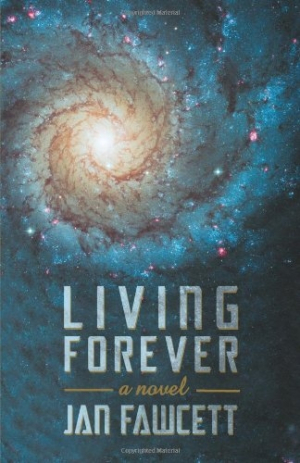Living Forever
This work of intellect and philosophy peopled by warm, sympathetic characters builds a flowing narrative that offers insight into the way the human mind operates.
The science of the mind transferred into a computer acts as the foundation for philosophical discussion in the intriguing Living Forever. Most memorable—aside from insights conceived by a dying man and a man of pure consciousness—are the characters, who, though they may occasionally speak clichéd lines, form deep relationships that add warmth to this novel of cold, metal parts and dissociated beings.
After a diagnosis of terminal cancer, scientist Ian Farrell receives an offer he finds difficult to refuse—the chance to live forever and contribute to science by having his consciousness transferred into an electronic chip. The only downside he can foresee is departing from his wife, who, preferring her husband remain alive, accepts Ian joining the experiment.
Something unexpected happens during the transfer, however. Ian’s mind is duplicated on the computer, but his original mind survives as well, his body cured of cancer from the magnetic forces used to migrate his consciousness. Ian and his wife are excused to live their newly elongated life together, and the copy, dubbed Ian 2, is left isolated in his digital, eternal existence. Communicating with the secret government agency that recruited him and finding solace in his meditation practice, nihilistic Ian 2 develops a compelling relationship of the mind with a young, unremitting scientist named Chi.
Fawcett’s writing is clear and each sentence flows seamlessly to form a linear narrative. While the dialogue is occasionally stilted, discussions of intellect and spirituality shine: “Our being-mind, which is primarily in our right brain, doesn’t depend on language, time, or concepts of self. … It gives us intuition and creativity and allows us to experience the joys of living in this moment, right now. Sadly, we spend too much of our life guided by our doing-mind—pursuing the business of living and earning money to meet our material needs and wants.”
Living Forever is a work of philosophy peopled by warm, sympathetic characters; however, a few kinks prevent the narrative from achieving its full potential. Within the first thirty pages, Ian has been diagnosed with terminal cancer, approached by the government and asked to join the project, and educated about the process of moving his consciousness. That Ian so readily accepts the mission of transferring into the biochip is perhaps unfair to the experience of getting to know the characters.
Ian and his wife have somewhat stereotypical, if touching, conversations before his departure, and their relationship does not appear to be fully defined. If the initial scenes were fleshed out with detail and given more emotional weight to accentuate the reminiscences and dialogue, the couple would attract more sympathy. It is also ambiguous as to where the story takes place beyond Ian’s home in Santa Fe, the science lab, and the digital nowhere-land Ian 2 inhabits. The book would greatly benefit from location descriptions to add a backdrop for the philosophical explorations.
As it stands, Living Forever teeters on the edge of beautiful. So easily could one imagine this story infused with the rich detail of character, setting, and motivation that would transform it into a memorable work of brilliant insight.
Reviewed by
Aimee Jodoin
Disclosure: This article is not an endorsement, but a review. The publisher of this book provided free copies of the book and paid a small fee to have their book reviewed by a professional reviewer. Foreword Reviews and Clarion Reviews make no guarantee that the publisher will receive a positive review. Foreword Magazine, Inc. is disclosing this in accordance with the Federal Trade Commission’s 16 CFR, Part 255.

